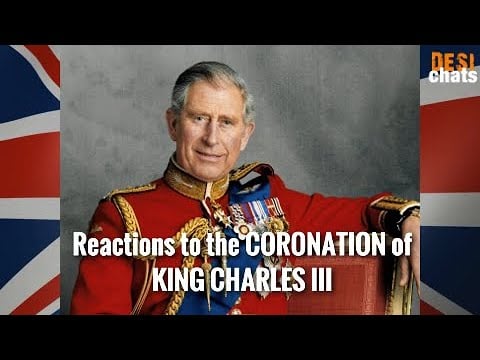An Overview of King Charles III’s Coronation
The historic Coronation of King Charles III took place and it saw many celebrity guests in attendance.
More than 2,000 people were at Westminster Abbey.
The service began with a procession.
Flags representing Commonwealth nations were carried through the ancient church, with prime ministers, governors and leaders from different faiths also involved.
The royals arrived on a modern diamond jubilee state coach and departed on the 260-year-old gold state coach.
They walked through the abbey to the Theatre of Coronation.
The service began at 11 am and King Charles III was greeted by a young chorister of the Chapel Royal and he replied that he came “not to be served but to serve”.
The Archbishop of Canterbury, Justin Welby, gave the greeting and introduction.
The Recognition

The Recognition dates back to the ancient procedures of the Witan – the supreme council of England in Anglo-Saxon times.
The King was presented to the congregation at each of the points of the compass – with a declaration at each turn.
“I here present unto you King Charles, your undoubted King.
“Wherefore all you who are come this day to do your homage and service: are you willing to do the same?”
The congregation and choir replied: “God save King Charles.”
The Archbishop of Canterbury performed the first of the compass-point declarations.
The Oath

King Charles III swore the coronation and accession declaration oaths on a specially commissioned Bible.
He promised to maintain the Anglican Protestant Church, rule according to parliament’s laws and uphold justice and mercy.
An anthem was sung before he moved to the high altar to pray aloud in front of the congregation – the first monarch to do so.
Prime Minister Rishi Sunak read The Epistle, while Dame Sarah Mullally, the dean of the Chapels Royal, followed with a passage from the Gospel.
Female clergy took part in a coronation for the first time.
The Archbishop of Canterbury then took centre stage with the keynote sermon.
After Veni Creator was sung, preparations were made for the King’s anointing, with the Archbishop in Jerusalem handing the oil to the Archbishop of Canterbury.
The Stone of Destiny
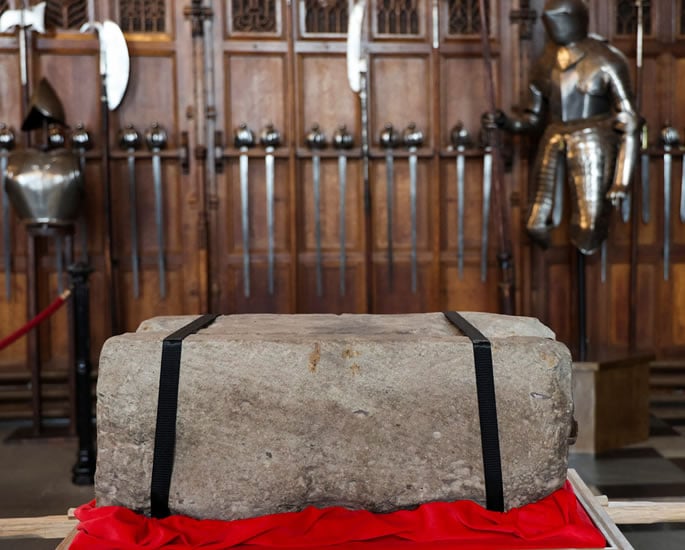
After the King’s robes of state were removed, he moved to the historic coronation chair.
A 152kg Stone of Destiny was placed inside the bottom of the chair, having been brought specially from Edinburgh Castle.
The anointing screen was moved in place by troops from the Household Division as the choir sang the anthem Zadok the Priest.
The archbishop, helped by the Dean of Westminster and the Archbishop of York, anointed the King on his hands, chest and head privately behind the screen.
Afterwards, King Charles III kneeled in front of the high altar as the Archbishop of Canterbury gave a blessing.
Crown Jewels

The King put on the coronation robes, which have been used in previous coronations.
The coronation regalia – the heart of the Crown Jewels and normally kept in the Tower Of London – was presented to the King by peers from the House of Lords and senior bishops.
After receiving the spurs, the King received the jewelled sword, which was clipped into his sword belt.
The King next received and acknowledged the gold armills. They are decorated with national emblems, such as roses, thistles and harps, and lined in red velvet.
Prince William then helped present his father with the stole royal.
Next was the golden orb, which represents the sovereign’s power.
The monarch’s ring was next.
The coronation glove was presented by Lord Singh of Wimbledon, with the King placing it on his right hand.
The sceptre with cross and rod with dove were the final items before the crowning.
Crowning Moment
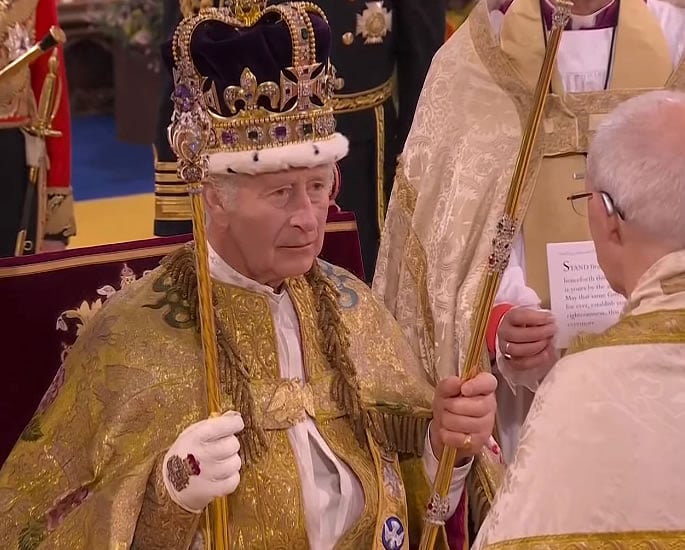
The Dean of Westminster handed St Edward’s crown to the Archbishop of Canterbury, who said a prayer of blessing before placing it on the King’s head.
He proclaimed “God save the King” – with the congregation echoing his words.
Westminster Abbey’s bells then rang for two minutes.
There was also a fanfare and a gun salute fired from the Horse Guards Parade, the Tower of London and at saluting stations across the UK – as well as from ships at sea.
Enthronement
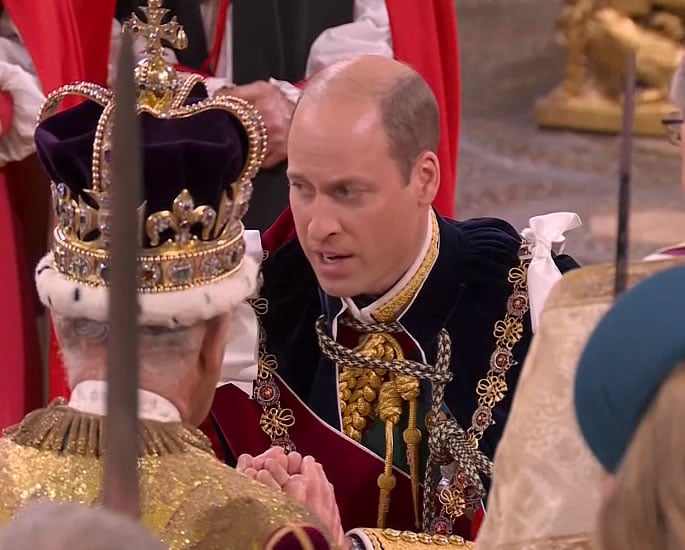
A blessing by church figures from across the UK followed before the King was accompanied by bishops and officers of state to his throne chair in the theatre of coronation.
The Archbishop of Canterbury led words of fealty to the King on behalf of the Church and promised to be “faithful and true”, while Prince William also gave homage.
Prince William said: “I, William, Prince of Wales, pledge my loyalty to you and faith and truth I will bear unto you, as your liege man of life and limb. So help me God.”
The congregation was then invited to participate in public homage or with a moment of private reflection, replacing the traditional homage of peers.
The enthronement section was finished with an anthem, Confortare by Sir Walford-Davies.
The Queen’s Coronation
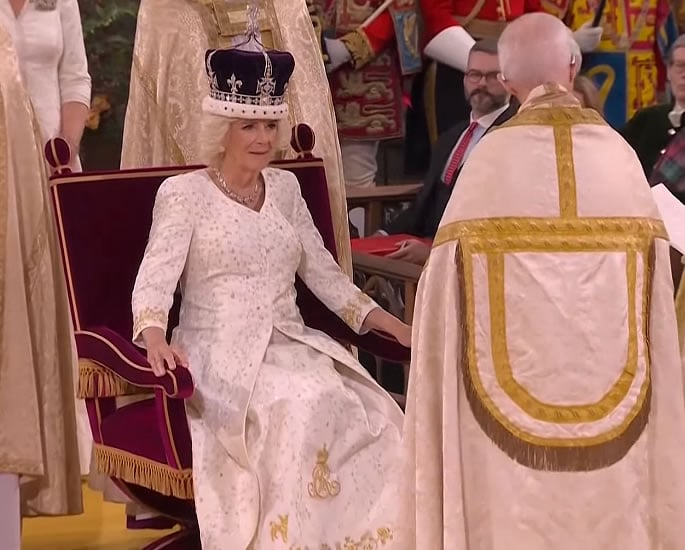
Attention then fell on the Queen Consort, who received her own regalia before being crowned.
Unlike the King, no privacy screen was used.
She was presented with a ring before the Dean of Westminster handed her crown to the archbishop.
To reflect the royals’ interest in sustainability, the Queen Consort used a ‘recycled’ version of the crown made for the 1911 coronation of Queen Mary, rather than having a new one made, as is usually the case.
The Queen Consort was then presented with a sceptre and the rod of “equity and mercy” by the Bishop of Dover and Lord Chartres.
The coronation anthem by Lord Andrew Lloyd Webber was performed while the Queen Consort sat in her own throne chair beside the King.
After another hymn, the couple removed their crowns and returned to the chairs of estate.
There was a final blessing before the congregation joined in with a rendition of the national anthem.
A change of costume also took place, as the royals headed to the Chapel of St Edward, behind the high altar, to put on their robes of estate.
The King also put on the imperial state crown – perhaps the most dazzling of the two used during the coronation.
The royals’ outward procession saw them receive a greeting from leaders and representatives of the Jewish, Hindu, Sikh, Muslim and Buddhist faiths.
It’s intended to recognise the religious diversity of the UK and Commonwealth.
They said: “Your Majesty, as neighbours in faith, we acknowledge the value of public service.
“We unite with people of all faiths and beliefs in thanksgiving, and in service with you for the common good.”
The King acknowledged their greeting before taking the gold state coach to Buckingham Palace, where the much-anticipated balcony moment will later take place.
Watch South Asian reactions to the Coronation
